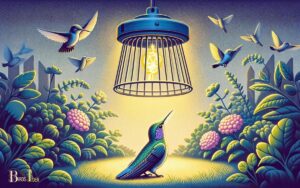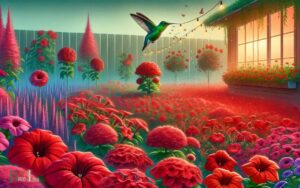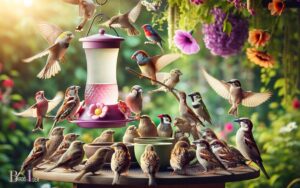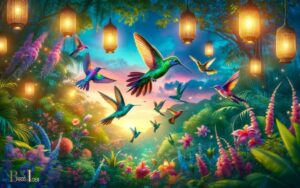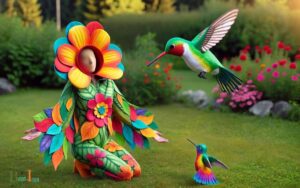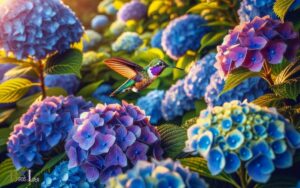Do Bottle Brush Trees Attract Hummingbirds? Yes!
Yes, bottle brush trees are known for attracting hummingbirds. The tree’s bright red flowers, which resemble a bottle brush, are rich in nectar and provide an excellent food source for these birds.
Bottle brush trees (Callistemon spp.) are popular among gardeners not only for their unique and vibrant flowers but also for their ability to attract wildlife, especially hummingbirds.
The high nectar production is a strong attractant, and the bright coloration of the flowers acts as a visual lure for the birds.
The blooming season for bottle brush trees generally coincides with the time when hummingbirds are most active, providing a reliable food source when it’s needed most.
Attracting hummingbirds to gardens, bottle brush trees not only provide aesthetic appeal but also support local biodiversity with their nectar-rich flowers.
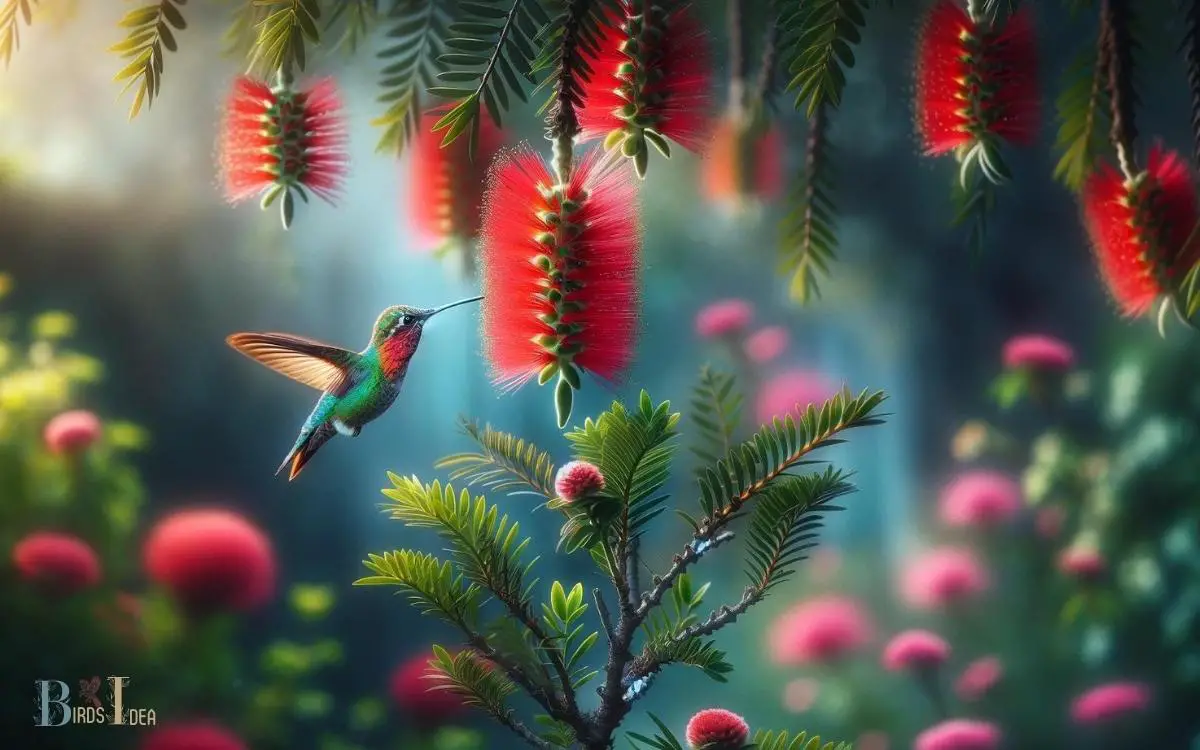
Key Takeaway
The Appeal of Bottle Brush Trees to Hummingbirds
Bottle brush trees appeal to hummingbirds due to their vibrant red flowers and nectar-rich blooms, attracting the tiny birds with their abundant food source.
The tubular shape of the bottle brush flower is particularly suited to the hummingbird’s long, slender bill, allowing them to easily reach the nectar.
The high nectar content of these flowers provides the energy that hummingbirds need for their rapid metabolism.
Additionally, the bright red color of the bottle brush flowers acts as a visual attractant for hummingbirds, as these birds are drawn to red hues.
The shape and color of the flowers, combined with the copious nectar they offer, make bottle brush trees a prime destination for hummingbirds seeking nourishment. This natural symbiotic relationship benefits both the tree and the bird.
Characteristics of Bottle Brush Trees
The characteristics of bottle brush trees, such as their evergreen foliage and compact, bushy growth habit, contribute to their appeal to hummingbirds as a reliable source of food and shelter.
The long, vibrant red or pink flowers of the bottle brush tree contain abundant nectar, which is a primary food source for hummingbirds.
These flowers are uniquely shaped, with long bristles that resemble a bottle brush, giving the tree its name.
The evergreen nature of the tree ensures that it provides consistent cover and nesting sites for hummingbirds throughout the year.
Additionally, the dense foliage and branching structure offer ideal perching and nesting locations for these tiny birds.
The bottle brush tree’s ability to thrive in various climates further enhances its desirability as a habitat for hummingbirds.
Hummingbird Attraction to Bottle Brush Trees
Bottle brush trees can draw hummingbirds due to their vibrant flowers and abundant nectar, providing a reliable food source for the tiny birds.
The bright red, pink, or white bristly flowers of the bottle brush tree are rich in nectar, which is a primary food source for hummingbirds.
These flowers are tubular in shape, perfectly suited for the long, slender bills of hummingbirds to access the nectar.
The vibrant and conspicuous flowers of the bottle brush tree serve as visual cues for hummingbirds, attracting them to feed.
Additionally, the continuous blooming cycle of bottle brush trees ensures a sustained nectar supply, making them an attractive and dependable food source for hummingbirds throughout the year.
This strong attraction to bottle brush trees contributes significantly to the overall benefits these trees offer to hummingbirds.
Benefits of Bottle Brush Trees for Hummingbirds
Bottle brush trees offer a reliable food source and vibrant visual cues for hummingbirds, enhancing their overall well-being and foraging success.
The nectar produced by the unique bottle brush flowers is rich in sugars, providing essential energy for hummingbirds’ high metabolic rates.
This abundant food source helps hummingbirds meet their daily energy requirements, especially during times of high activity, such as breeding and migration.
Additionally, the bright red flowers of the bottle brush tree act as visual beacons, attracting hummingbirds from a distance and aiding in their navigation.
This visual stimulation not only benefits the birds but also provides an aesthetic appeal for observers.
Overall, the presence of bottle brush trees in an area can significantly contribute to the health and vitality of local hummingbird populations.
Planting and Caring for Bottle Brush Trees
One popular method for planting and caring for bottle brush trees is to ensure they receive adequate sunlight and well-draining soil.
These trees thrive in full sun and prefer soil that is slightly acidic to neutral. When planting, it’s important to dig a hole that is as deep as the root ball but twice as wide to allow for the roots to spread.
After planting, it’s crucial to water the tree regularly, especially during dry periods, to help establish a strong root system.
Applying a layer of mulch around the base of the tree can help retain moisture and regulate soil temperature.
Additionally, bottle brush trees benefit from occasional pruning to maintain their desired shape and promote healthy growth.
Following these care guidelines can help ensure the successful growth and development of bottle brush trees in a garden or landscape.
Other Plants That Attract Hummingbirds
Many gardeners may wonder about other plants that attract hummingbirds. These alternative hummingbird-friendly plants can complement bottle brush trees. Diverse nectar-producing flora can create a vibrant and attractive garden for hummingbirds.
Alternative Hummingbird-Friendly Plants
While bottle brush trees are known to attract hummingbirds, there are many alternative plants that also serve as attractive options for these vibrant birds.
Salvias, also known as sage, are a popular choice for attracting hummingbirds due to their tubular, nectar-filled flowers.
Another excellent option is the trumpet vine, which produces large, trumpet-shaped flowers that hummingbirds find irresistible.
Bee balm, with its colorful blooms and high nectar content, is another favorite among hummingbirds.
Additionally, plants like columbine, penstemon, and fuchsia are known to attract hummingbirds with their vibrant flowers and nectar.
By incorporating a variety of these alternative hummingbird-friendly plants into the garden, one can create a diverse and inviting habitat for these beloved birds.
Diverse Nectar-Producing Flora
Bee balm, salvia, and penstemon are popular choices for attracting hummingbirds due to their tubular-shaped flowers, which are perfectly adapted for the birds’ long, slender bills.
These plants provide ample nectar for hummingbirds and are easy to grow in a variety of climates.
Other nectar-producing flora that can attract hummingbirds include:
- Columbine: This delicate flower with its spurs filled with nectar is a favorite of hummingbirds, especially in woodland gardens.
- Trumpet Vine: Known for its vibrant, trumpet-shaped flowers, this vine is a magnet for hummingbirds and can quickly cover a trellis or fence.
- Lupine: The tall spikes of lupine flowers not only add beauty to the garden but also provide a nectar source that hummingbirds find irresistible.
These diverse plants offer a range of colors and growth habits, ensuring a continuous supply of nectar to keep hummingbirds coming back.
Creating a Hummingbird-Friendly Garden
To attract hummingbirds, gardeners can create a welcoming environment by planting nectar-rich flowers and providing adequate water sources.
Hummingbirds are attracted to bright, tubular flowers such as salvia, bee balm, and trumpet vine.
These flowers provide the high-energy nectar that hummingbirds need to fuel their rapid metabolism.
It’s important to choose a variety of flowers that bloom at different times throughout the year to ensure a constant nectar supply.
Additionally, incorporating a water feature like a birdbath or a small fountain can provide hummingbirds with a place to drink and bathe.
When designing a hummingbird-friendly garden, it’s crucial to avoid using pesticides and herbicides, as these chemicals can be harmful to these delicate birds.
By creating a garden with these elements, gardeners can attract and support these beautiful, energetic creatures.
Conclusion
Bottle brush trees are a beautiful and enticing addition to any garden, attracting hummingbirds with their vibrant red flowers and nectar.
With their low maintenance and ability to thrive in various climates, they are a perfect choice for creating a hummingbird-friendly environment.
So, why not add a bottle brush tree to your garden and enjoy the delightful presence of these tiny, colorful birds?

